1996 PONTIAC BONNEVILLE engine
[x] Cancel search: enginePage 119 of 387
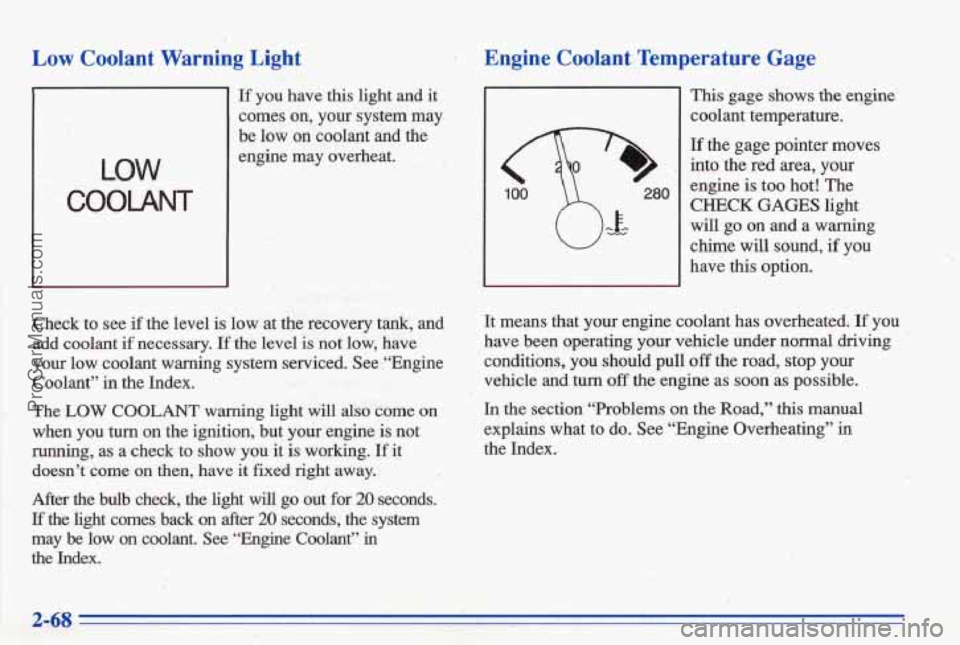
Low Coolant Warning Light
LOW
COOLANT
If you have this light and it
comes on, your system may
be low on coolant and the
engine may overheat.
Check to see
if the level is low at the recovery tank, and
add coolant if necessary. If the level is not low, have
your low
coolant warning system serviced. See “Engine
Coolant”
in the Index.
The
LOW COOLANT warning light will also come on
when you
turn on the ignition, but your engine is not
running, as a check to show you it is working. If it
doesn’t come on then, have
it fixed right away.
After the buIb check, the light will go out for 20 seconds.
If the light comes back on after 20 seconds, the system
may
be low on ,coolant. See “Engine Coolant’’ in
the Index.
Engine Coolant Temperature Gage
This gage shows the engine
coolant temperature.
If the gage pointer moves
into the red
,area, your
engine
is too hot! The
CHECK GAGES light
will
go on and a warning
chime
will sound, if you
have this option.
It means that your engine coolant has overheated.
If you
have been ‘operating your vehicle under
normal driving
conditions,
you should pull off the road, stop your
vehicle
and turn ,off the engine as soon as possible.
In the section “Problems on the Road,” this manual
explains what to do. See “Engine Overheating”
in
the Index.
, .-; ’.
. . -.
ProCarManuals.com
Page 120 of 387
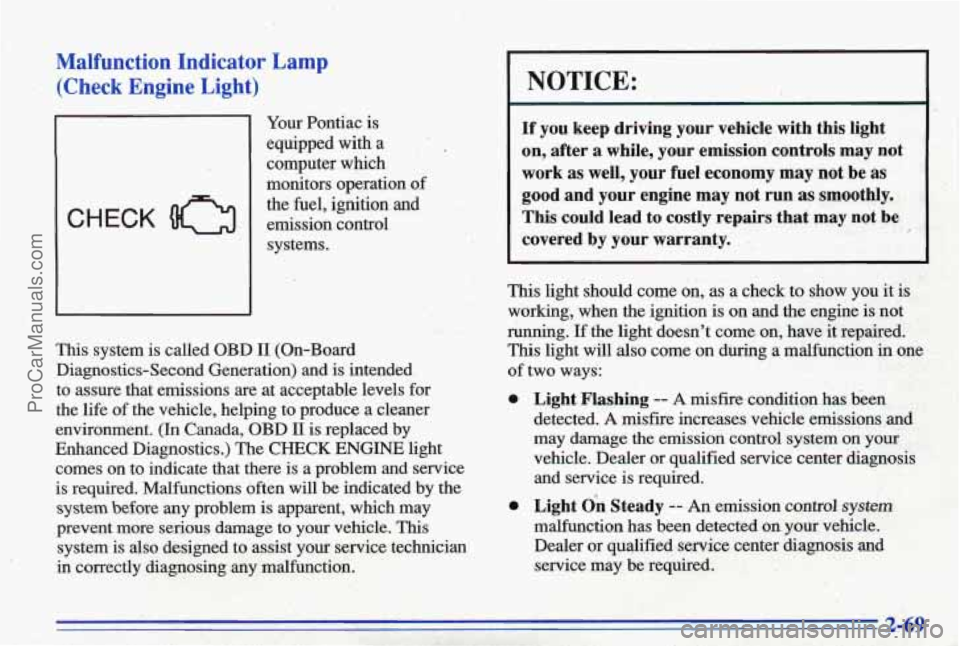
Malfunction Indicator Lamp
(Check Engine Light)
CHECK
Your Pontiac is
equipped with.a
, ' .
computer which
monitors operation of
the fuel, ignition and
emission control systems.
This system is called OBD 11 (On-Board
Diagnostics-Second Generation) and is intended
to assure that emissions are at acceptable levels for
the life of the vehicle, helping to produce a cleaner
environment.
(In Canada, OBD 11 is replaced by
Enhanced Diagnostics.) The CHECK ENGINE light
comes on to indicate that there is a problem and service
is required. Malfunctions often will be indicated by the
system before any problem is apparent, which may
prevent more serious damage to your vehicle.
This
system is also designed to assist your service technician
in correctly diagnosing any malfunction.
NOTICE: 1.
If you keep driving your vehicle with this light
on, after a while, your emission controls may not
work as well, your fuel economy may not be as
good and your engine may not run
as smoothly.
This could lead to costly repairs that may not be
covered by your warranty.
.
This light should come on, as a check to show you it is
working, when the ignition is on and the engine is not
running.
If ,the light doesn't come on, have it repaired.
This light will also come on during a malfunction in one
of two ways:
0
0
Light Flashing -- A misfire condition has been
detected.
A misfire increases vehicle emissions and
may damage the emission control system on your
vehicle. Dealer or qualified service center diagnosis and service is required.
Light On Steady -- An emission control system
malfunction has been detected on your vehicle. Dealer or qualified service center diagnosis and
service may be required.
ProCarManuals.com
Page 121 of 387
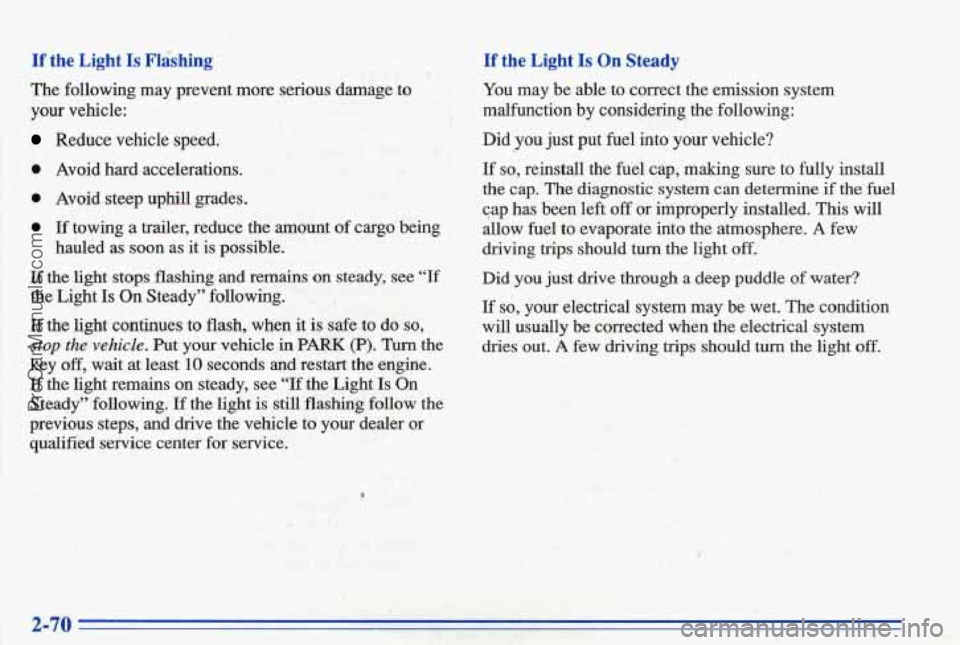
If the Light Is Flashing
The following may prevent more serious damage to
your vehicle:
Reduce vehicle speed.
0 Avoid liard accelerations.
~ .I.<.’.) . .e ,,- .I - ..
L:‘:’r’ j. ,
0 If towing a trailer, reduce the amount of wgo being
hauled as soon as it is possible.
If the light stops flashing and remains on steady, see “E
the Light Is On Steady” following.
If the light continues to flash,, when it is safe to do so,
stop the vehicle. Put your vehicle in PARK (P), Turn the
key off, wait at least 10 seconds and restart the engine.
If the light remains on steady, see “If the Light Is On
Steady” following. If the light is still flashing follow the
previous steps, and drive the vehicle to your dealer or
qualified service center for service.
If the Light Is On Steady
You may be able to correct the emission system
malfunction b’y considering the following:
Did
you just put fuel into your vehicle?
If so, reinstall the fuel cap, making sure to fully install
the
cap. The diagnostic system can determine if the fuel
cap
has been left off or improperly installed. This will
allow fuel to evaporate into the atmosphere. A few
driving trips should turn the light off.
Rid you just drive through a deep puddle of water?
If so, your electrical system may be wet. The condition
will usually be corrected when the electrical system
dries out. A few driving trips should turn the light off.
ProCarManuals.com
Page 122 of 387
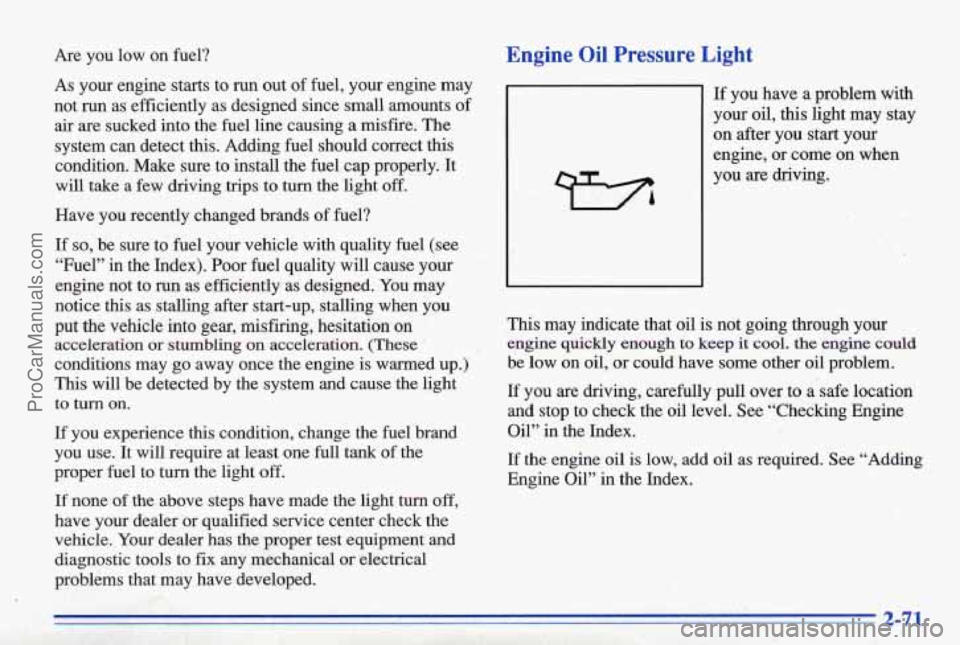
Are you low on fuel?
As your engme starts to run out of fuel, your engine may
not run as’ efficiently as designed since small- amounts
of
air are sucked into the fuel line causing a misfire. The
system can detect this. Adding fuel should correct this
condition. Make sure to install the fuel cap properly. It
will take a few driving ,trips
to turn the light off.
Have you recently changed brands of fuel?
If so, be sure to fuel your vehicle with quality fuel (see
“Fuel”
in the Index). Poor fuel quality will cause your
engine not to run as efficiently as designed.
You may
notice
this as stalling after start-up, stalling when you
put the vehicle into gear, misfiring, hesitation on
acceleration or
stumbling on acceleration. (These ’
conditions may go away once the engine is warmed up.)
This will be detected by the system and cause the light
to
Imn on.
If you experience this condition, change the fuel brand
you use. It will require at least one full tank of the
proper fuel
to turn the light off.
If none of the above steps have made the light turn off,
have your dealer or qualified service center check the
vehicle. Your dealer has the proper test equipment.
and
diagnostic tools to fix any mechanical or electrical
problems that may have developed.
Engine Oil Pressure 1,ig.ht
If you have a problem with
your oil, this light may
stay
on after you start your
engine,
or come on when
you are driving.
This may indicate that oil is not going through your
engine quickly enough to keep it cool. the engine could
be low on oil, or could have some other oil problem.
If you are driving, carefully pull over to a safe location
and stop to check the oil level. See “Checking Engine
Oil” in the Index.
If the engine oil is low, add oil as required. See “Adding
Engine
Oil” in the Index.
3 71
ProCarManuals.com
Page 123 of 387
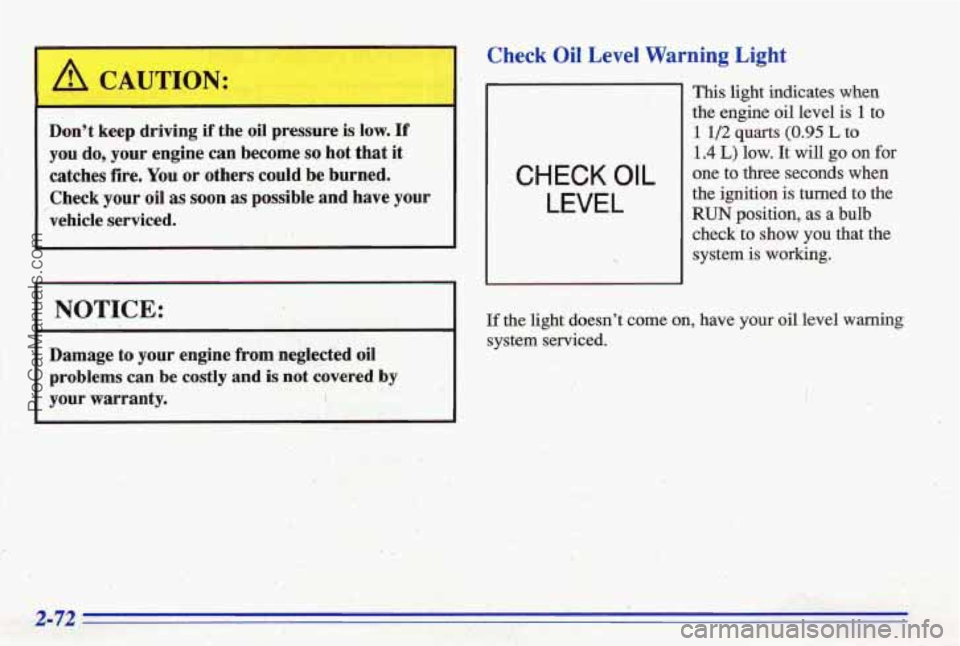
I /r CAUTION:
Don't keep driving if the oil pressure is low. If
you do,. your engine can become so hot that it
catches fire.
You or others could be burned.
Check your oil
as soon as possible and have your
vehicle serviced.
I NOTICE: Ir
r
~ ~~
Damage to your engine from neglected oil
problems can be costly and is not covered by
your warranty.
- '
Check Oil Level Warning Light
CHECK OIL
LEVEL
This light indicates when
the engine
oil level is 1 to
1 1/2 quarts (0.95 L to
1.4 L) low. It will go on for
one to three seconds when
the ignition
is turned to the
RUN position, as a bulb
check to show you that the
system
is working.
If the light doesn't come on, have your oil level warning
svstem serviced.
:? ' .C. .:
ProCarManuals.com
Page 124 of 387
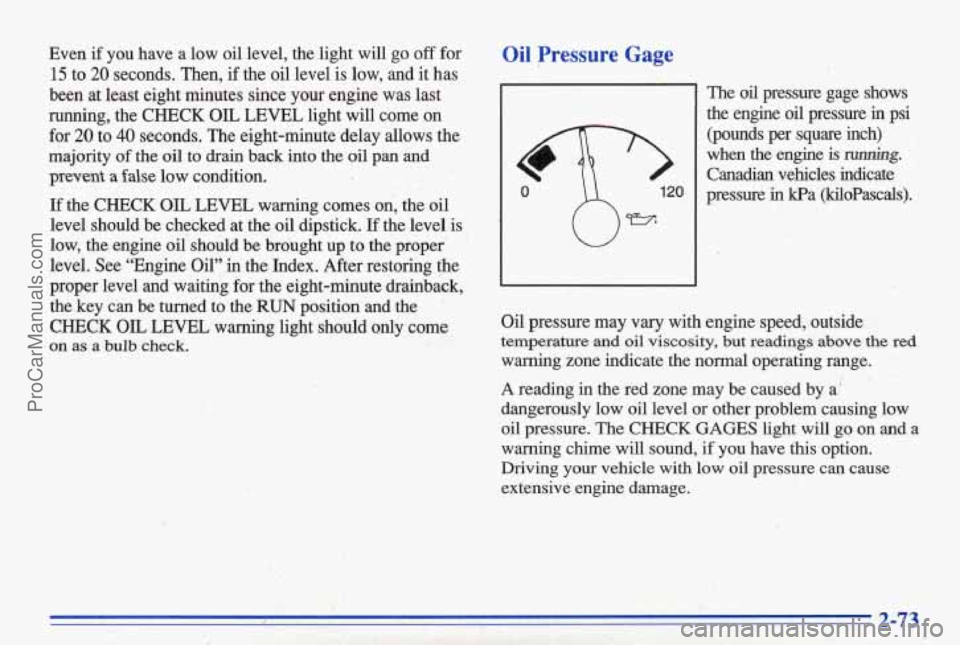
Even if you have a low oil level, the light will go off for
15 to 20 seconds. Then, if the oil level is low, and it has
been at least eight minutes
since your engine was last
running, the
CHECK OIL LEVEL light will come on
for
20 to 40 seconds. The eight-minute delay allows the
majority of the oil to drain back into the oil pan and
prevent a false low condition.
If the CHECK OIL LEVEL warning comes on, the oil
level should be checked at the oil dipstick. If the level is
low, the engine
oil should be brought up to the proper
level. See “Engine Oil” in the Index. After restoring the\
proper level and waiting for the eight-minute drainback,
the key can be turned to the
RUN position and the
CHECK OIL LEVEL warning light should only come
on as a bulb check.
Oil Pressure Gage
The oil pressure gage shows
the engine
oil pressure in psi
(pounds per square inch)
when
the engine is rwmhg.
Canadian vehicles indicate
pressure in kPa (kiloPascals).
Oil pressure may vary with engine speed, outside
temperature and oil viscosity, but readings above the red
warning zone indicate the normal operating range.
A reading in the red zone may be caused by a,’
dangerously low
oil level or other problem causing low
oil pressure.
The CHECK GAGES light will go on and. a
warning ch@e
will sound, if you have this option.
Driving your
vehicle with low oil pressure can cause
extensive ,engine, damage.
ProCarManuals.com
Page 125 of 387
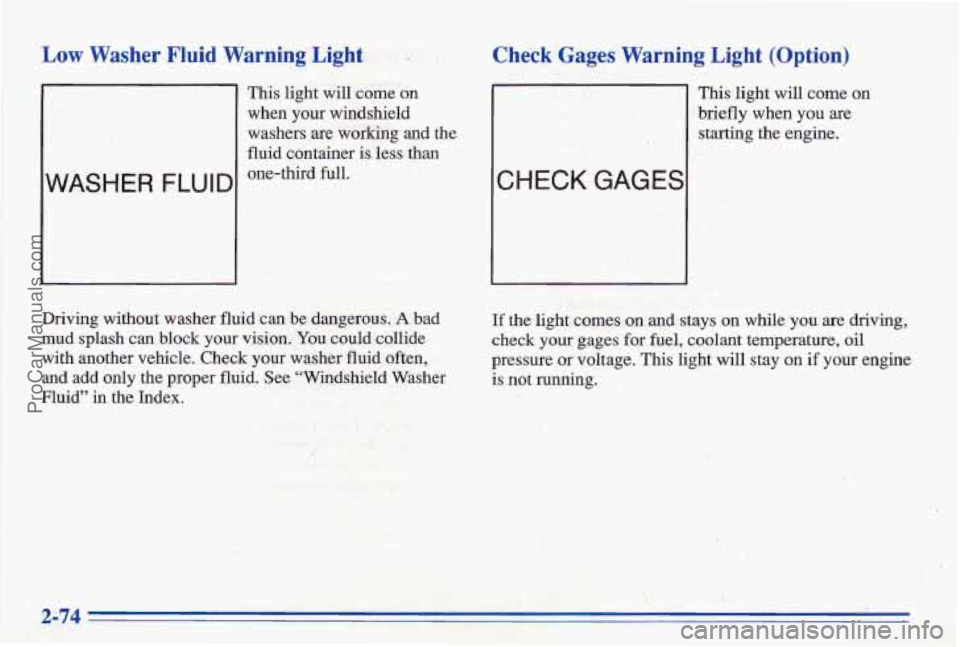
Low Washer Fluid Warning Light
WASHER FLUID
This light will come on
when your windshield
washers are working 'and the
fluid container is less
than
one-third full.
Check Gages Warning ,, Light (Option)
CHECK GAG.ES
This light will come on
briefly when you are
starting the engine.
Driving without washer fluid canbe dangerous.
A bad
mud splash can block
your vision. You could collide
with another vehicle. Check your washer
fluid often,
and add only the proper fluid. See "Windshield Washer
Fluid" in
the Index.
If the light comes on and stays on while you are driving,
check your gages for fuel, coolant temperature, okl
pressure or voltage. This light will stay on if your engine
is not running.
... . - ._
ProCarManuals.com
Page 126 of 387
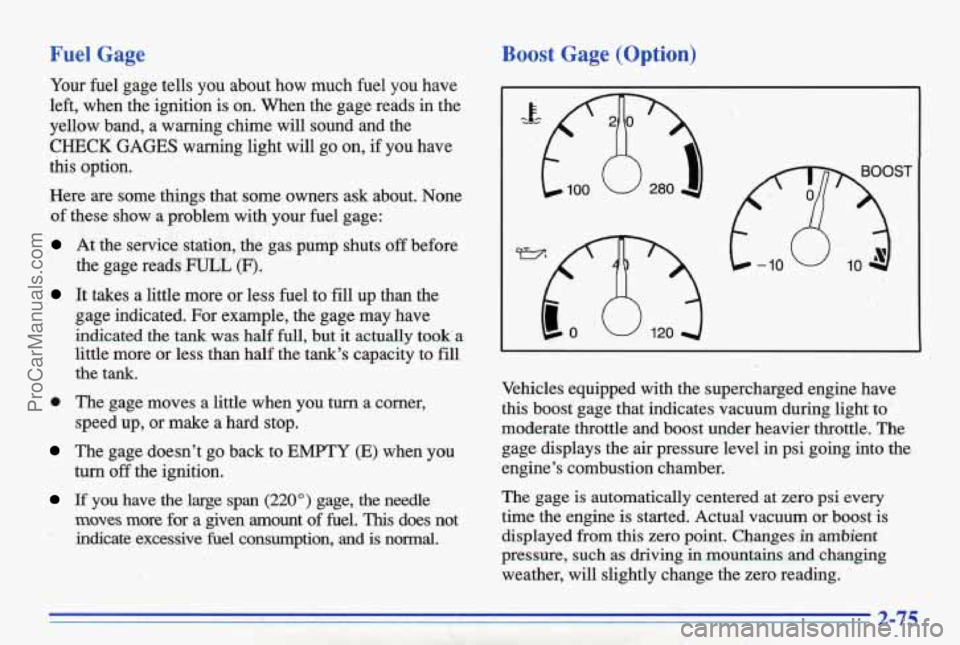
Fuel Gage
Your fuel gage tells you about how much fuel you have
left, when the ignition is on. When the gage reads in the
yellow band, a warning chime will sound and the
CHECK GAGES warning light will go on, if you have
this option.
Here
are some things that some owners ask about. None
of these show a problem with your fuel gage:
At the service station, the gas pump shuts off before
It takes a little more or less fuel to fill up than the
the
gage reads
FULL (F).
gage indicated. For example, the gage may have
indicated the tank was half full, but it actually took a
little more or less than half the tank's capacity to fill
the tank.
0 The gage moves a little when you turn a corner,
The gage doesn't go back to EMPTY (E) when you
If you have the large span (220") gage, the needle
speed up, or make a hard stop.
turn off the ignition.
moves more
for a given amount of fuel. This does not
indicate excessive
fuel consumption, and is normal.
Boost Gage (Option)
OST
Vehicles equipped with the supercharged engine have
this boost gage that indicates vacuum during light to.
moderate throttle and boost under heavier throttle. The
gage displays the air pressure level in psi going into the
engine's combustion chamber.
The gage
is automatically centered at zero psi every
time the engine is started. Actual vacuum or boost is
displayed from this zero point. Changes
in ambient
pressure, such as driving in mountains and changing
weather, will slightly change the zero reading.
ProCarManuals.com